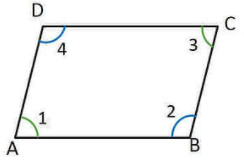Theorem 8.5 : If in a quadrilateral, each pair of opposite angles is equal, then it is a parallelogram.

By angle sum property of quadrilateral
∠1+∠2+∠3+∠4=360
∠1+∠2+∠1+∠2=360
2(∠1+∠2)=360
∠1+∠2=180
For lines AD and BC with AB as transversal,
∠1 and ∠2 are interior angles on the same side of transversal,
Hence, AD∣∣BC
Topper's Solved these Questions
- NCERT THEOREMSBOOK - NCERT ENGLISHCHAPTER - NCERT THEOREMSEXERCISE - THEOREM 8.6
1 Videos
- NCERT THEOREMSBOOK - NCERT ENGLISHCHAPTER - NCERT THEOREMSEXERCISE - THEOREM 8.7
1 Videos
- NCERT THEOREMSBOOK - NCERT ENGLISHCHAPTER - NCERT THEOREMSEXERCISE - THEOREM 8.4
1 Videos
- LINES AND ANGLESBOOK - NCERT ENGLISHCHAPTER - LINES AND ANGLESEXERCISE - Exercise 6.1
6 Videos
- NUMBER SYSTEMSBOOK - NCERT ENGLISHCHAPTER - NUMBER SYSTEMSEXERCISE - EXERCISE 1.4
2 Videos
Similar Questions
Theorem 8.3 : If each pair of opposite sides of a quadrilateral is equal, then it is a parallelogram.
View SolutionWhich of the following statements are true (T) and which are false (F)? (i) In a parallelogram, the diagonals are equal. (ii) In a parallelogram, the diagonals bisect each other. (iii) In a parallelogram, the diagonals intersect each other at right angles. (iv) In any quadrilateral, if a pair of opposite sides is equal, it is a parallelogram. (v) If all the angles of a quadrilateral are equal, it is a parallelogram. (vi) If three sides of a quadrilateral are equal , it is a parallelogram. (vii) If three angles of a quadrilateral are equal, it is a parallelogram. (viii) If all the sides of a quadrilateral are equal it is a parallelogram
View SolutionA quadrilateral is parallelogram if its opposite angles are equal.
View SolutionGiven statements in (a) and (b). Identify the statements given below as contrapositive or converse of each other.(a) If you live in Delhi, then you have winter clothes. (i) If you do not have winter clothes, then you do not live in Delhi. (ii) If you have winter clothes, then you live in Delhi.(b) If a quadrilateral is a parallelogram, then its diagonals bisect each other. (i) If the diagonals of a quadrilateral do not bisect each other, then the quadrilateral is not a parallelogram. (ii) If the diagonals of a quadrilateral bisect each other, then it is a parallelogram.
View SolutionComplete each of the following statements by means of one of those given in brackets again each: If one pair of opposite sides are equal and parallel, then the figure is ............... (parallelogram, rectangle, trapezium) If in a quadrilateral only one pair of opposite sides are parallel, the quadrilateral is .............. (square, rectangle, trapezium) A line drawn from the mid-point of one side of a triangle .................. another side intersects the third side at its mid-point. (perpendicular to, parallel to, to meet) If one angle of a parallelogram is a right angle, then it is necessarily a .................... (rectangle, square, rhombus) Consecutive angles of parallelogram are ...................... (supplementary, complementary) If both pairs of opposite sides of a quadrilateral are equal, then it is necessarily (rectangle, parallelogram, rhombus) if opposite angles of a quadrilateral are equal, then it is necessarily a ................... (parallelogram, rhombus, rectangle) If consecutive sides of a parallelogram are equal, then it is necessarily a ............. (kite, rhombus, square)
View SolutionThe midpoint of two opposite sides of a quadrilateral and the midpoint of the diagonals are the vertices of a parallelogram. Prove that using vectors.
View SolutionIf the diagonals of a quadrilateral bisect each other, then the quadrilateral is a parallelogram.
View SolutionA quadrilateral is a parallelogram if its opposite sides are equal.
View SolutionTheorem 10.11 : The sum of either pair of opposite angles of a cyclic quadrilateral is 180º.
View SolutionIf the diagonals of a quadrilateral bisect each other at right angle, then the quadrilateral is a (a) parallelogram (b) rectangle (c) rhombus (d) kite
View Solution
